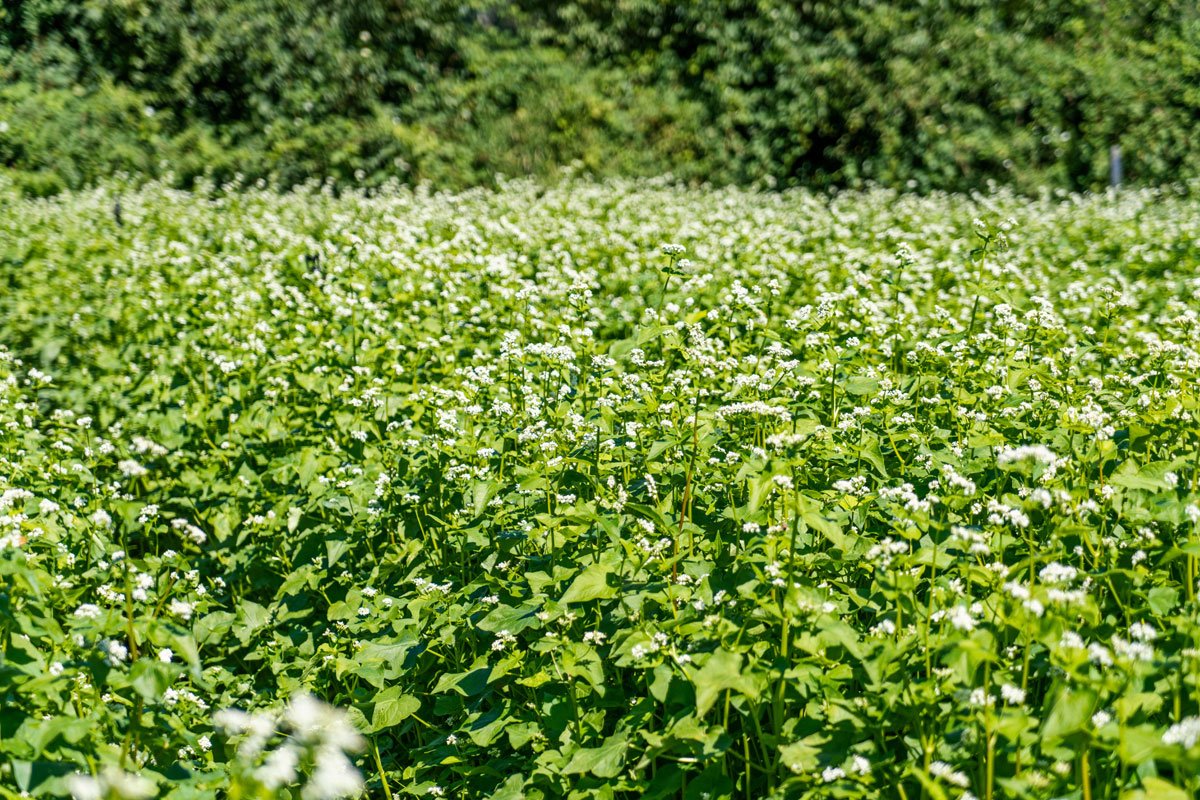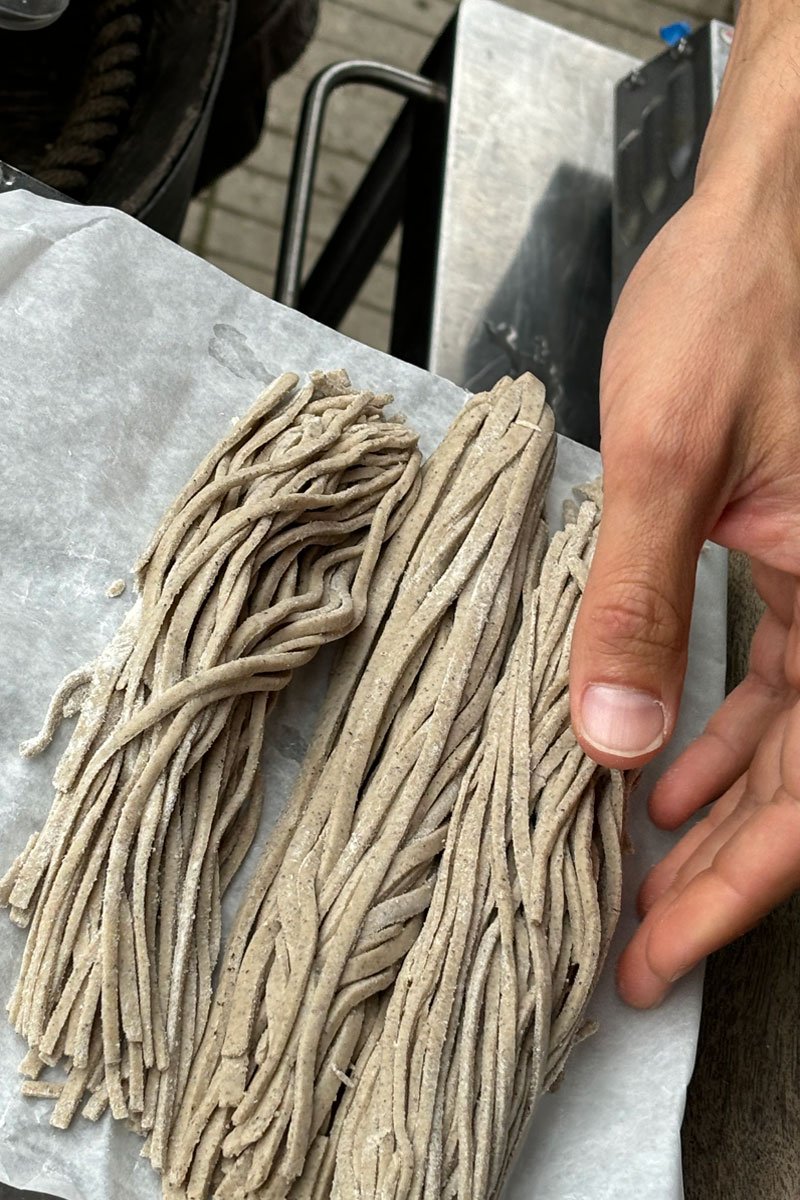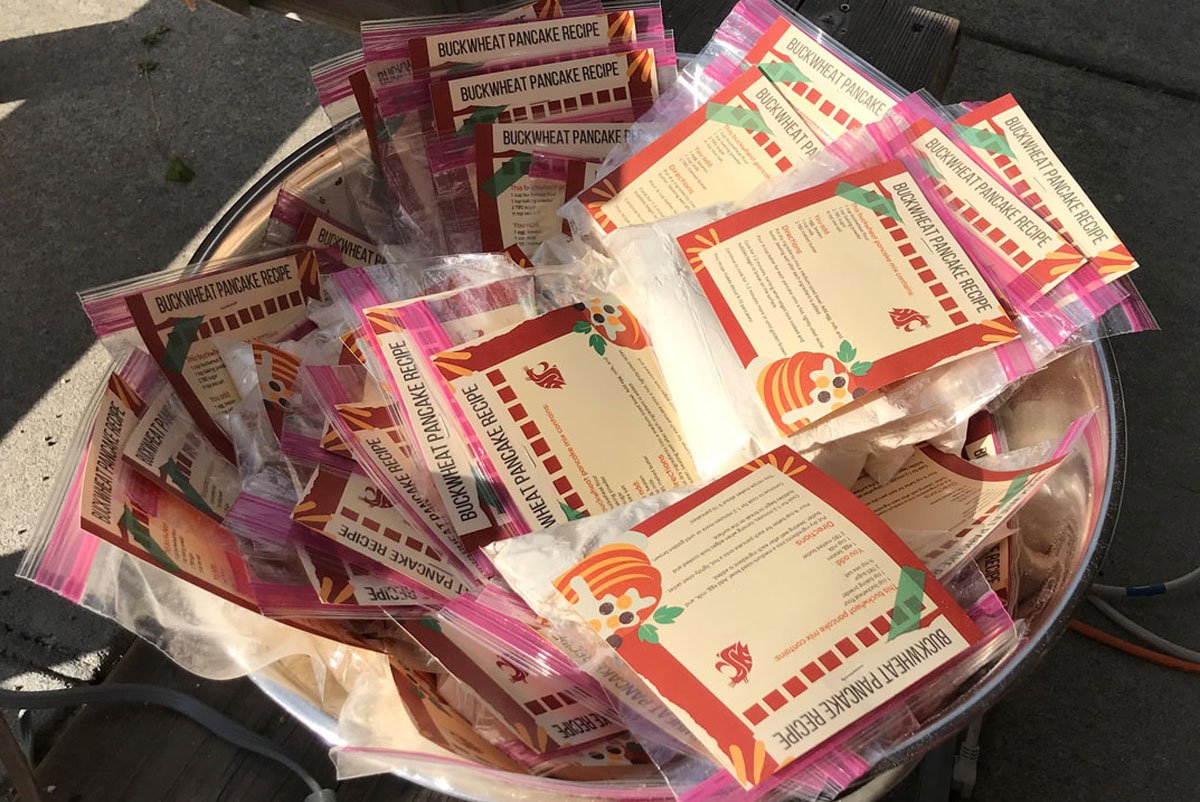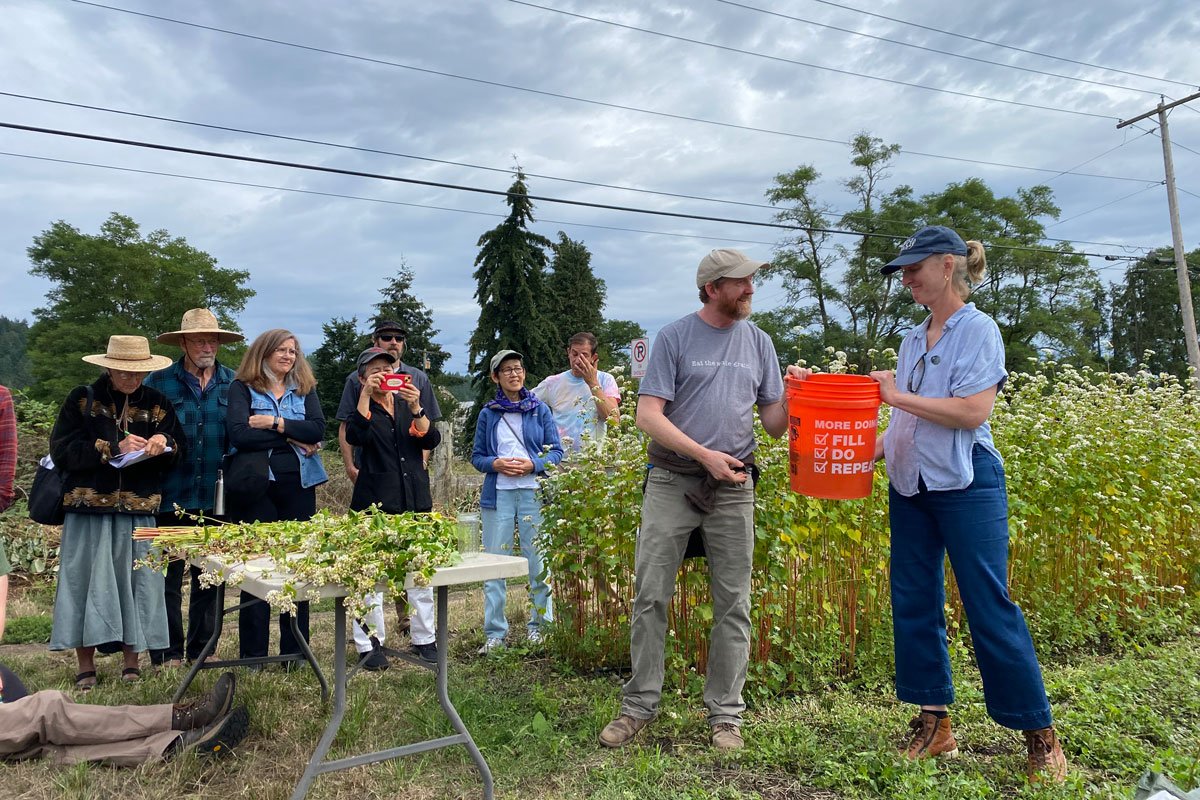Farmers and researchers are working together to expand organic buckwheat production in the Northwest and drive demand for this nutritious, ecologically beneficial seed.

Farmers and researchers are working together to expand organic buckwheat production in the Northwest and drive demand for this nutritious, ecologically beneficial seed.
July 8, 2025

A single buckwheat plant can produce as many as 2,000 flowers. Experts recommend planting about 700,000 buckwheat plants per acre. (Photo credit: Mark Hatfield/Getty)
From a distance, fields of buckwheat may seem serene, with petite, fluffy white flowers and heart-shaped green leaves. But if you’re standing in one, you’ll hear the distinct buzzing of bees as they pollinate millions of flowers per acre.
Expand your understanding of food systems as a Civil Eats member. Enjoy unlimited access to our groundbreaking reporting, engage with experts, and connect with a community of changemakers.
Already a member?
Login
“Bees love buckwheat,” says Keith Kisler, a farmer who co-owns Chimacum Valley Grainery, a mill, bakery, and brewery on Washington’s Olympic Peninsula. Kisler and his wife, Crystie, cultivate barley, quinoa, rye, spelt, and wheat on about 70 acres of organic farmland, but buckwheat has become one of his favorite crops.
Despite its name, buckwheat is not a type of wheat; it’s a gluten-free seed, rich in vitamins and minerals.
That’s because buckwheat—planted in late May and harvested in early October—is remarkably easy to grow. “In between, there’s really nothing done to that field,” Kisler says. “I don’t do any weed control, and we don’t water. It’s planted, it germinates, it grows, it flowers, it’s harvested.”
Buckwheat is also easy to mill into flour and adds a rich, earthy flavor to some of the Grainery’s products, like bread, beer, and pasta. By managing every step of the process, from cultivation to the finished product, Kisler has overcome buckwheat’s greatest challenge in the U.S.—a solid infrastructure that connects producers with consumers.

Buckwheat flour can be used in a range of recipes, including noodles, pictured here, as well as crêpes, blinis, and cookies. (Photo credit: Crystie Kisler, Chimacum Valley Grainery)
Buckwheat has a long bloom period, can build healthy soil, and is nutrient-dense, making it good not only for bees and farmers, but also planet and people. These multiple benefits are why Kisler and a team of scientists are working together to test new varieties of buckwheat and to build a local market for it.
Led by researchers at Washington State University (WSU) and supported by funding from the U.S. Department of Agriculture (USDA), they hope to increase organic production of this underutilized, low-input crop—one with the potential to address larger challenges like nutrition access and climate change.
A Versatile Seed
Despite its name, buckwheat is not a type of wheat. It is a seed rich in vitamins and minerals, including vitamins A, B, C, and E, as well as potassium and magnesium, which play an important role in a healthy human diet—and it is gluten free. The tough outer hulls are typically removed, and the hulled seeds, called groats, have a nutty taste and the al dente texture of farro. Buckwheat groats can also be milled into a flour for use in sweet and savory recipes, from brownies and cookies to breads and crackers.
Buckwheat originated in southwestern China, featuring in Asian cuisines for thousands of years before spreading to Eastern Europe, likely in the 15th century. Today, China is the world’s second largest producer of buckwheat after Russia. The grain arrived in North America during European colonization and was a favorite of Thomas Jefferson and George Washington, due to its capacity to suppress weeds.
Its culinary uses, however, have yet to be fully explored in the U.S., where it is still typically treated as an export item or cover crop. About 27,000 acres of buckwheat were grown here in 2017, the most recent year that data on buckwheat plantings were available.
Washington is the nation’s second top producer of buckwheat after North Dakota, with approximately 6,000 to 8,000 acres, according to Kevin Murphy, a WSU professor of international seed and cropping systems and the director of Breadlab, WSU’s grain research center. Almost all of the seed grown in the Northwest state is exported to Japan for making soba noodles.
Kisler’s buckwheat, grown on 12 acres that produce 16,000 to 18,000 pounds of seed annually, remains in his regional food system. His brother, on the other hand, grows between 200 and 300 acres of buckwheat in eastern Washington, entirely for export to Japan.
“There’s a need for different scales of operations,” Kisler says. “For somebody like my brother to grow several hundred acres of buckwheat and for small production at a local level.”
Kisler has worked with Breadlab since 2008, and the buckwheat in his fields are varieties they developed together. For years before this collaboration, Kisler used buckwheat as a cover crop, and he saw how it enhanced his soil.
“It helps break disease cycles,” Kisler says. “It grows really quickly, so it out-competes the weeds in a field. It sends down a fairly deep tap root, which loosens compacted soils. It does well even in marginal soils. I don’t ever need to water it, even in a dry season. And it’s planted later, so from a production perspective, it spreads out planting and harvesting so all that work doesn’t need to happen all at once.”
Buckwheat’s agricultural benefits extend beyond the lifespan of the plant. “When I follow it with a grain crop, that grain crop does better in that section of the field where there was buckwheat the previous year than next door where there was no buckwheat planted,” Kisler says.
The Pancake Project
In 2021, WSU researchers began collaborating with local producers to assess the regional market for buckwheat and millet and build consumer demand for these crops, supported by a $350,000 Sustainable Agriculture Research and Education Project (SARE) grant, funded by the USDA.
“I don’t do any weed control with buckwheat, and we don’t water. It’s planted, it germinates, it grows, it flowers, it’s harvested.”
They used the most promising buckwheat varieties from nearby farms to develop a pancake mix for Washington’s school lunch programs. Stephen Bramwell, Thurston County Extension director and WSU agriculture specialist, coordinated with nearly 300 school districts for their feedback. A critical factor, they found, was the ratio of buckwheat flour to whole wheat flour.
“After many rounds of taste tests at the Breadlab and schools, we’ve dialed it in to 50 percent buckwheat,” Bramwell says. “We tried to get it close to what people know, what wouldn’t be too different from other pancakes—fairly light, not too grainy, a little bit sweet.”
The pancakes’ appearance was particularly crucial. “The color—that’s a huge one for kids,” says Bramwell, noting that students prefer the lighter hue of pancakes made with refined wheat flour. “Buckwheat pancakes brown faster and can become really dark, so we’ve done trials to moderate the color.”

Buckwheat pancake-mix packets at the Thurston County Fair, created by WSU Extension. At the booth, kids could grind their own buckwheat flour for the packets using a hand-crank mill. The booth was extremely popular, with some kids returning two or three times to grind more buckwheat groats. (Photo credit: Stephen Bramwell)
To familiarize students with buckwheat, the team also organized hands-on lessons, including growing it in school gardens, harvesting and threshing it, using hand-crank mills to pulverize the seeds into flour, making pancakes, and taste testing batches made with different flour ratios.
“The best way to reach kids is not just when it shows up on the plate,” Bramwell says, “but when they’ve had a chance to get exposure to a new product by learning about it, as a plant, as a seed, and then as a food.”
‘More Bang for Your Buckwheat’
After the SARE grant ended in 2024, the WSU team received another USDA grant for a project they call More Bang for Your Buckwheat (MBYB). Their goal is to develop new buckwheat varieties based on traits that both farmers and consumers like and want. With these new varieties, the team plans to develop a diverse selection of “flavorful, affordable, and nutritious” buckwheat products and continue collaborations with 50 school districts in the region.
“The name is sort of tongue-in-cheek,” explains Micaela Colley, WSU professor of participatory plant breeding. “Many farmers grow buckwheat knowing they won’t make any money off it, and they just till it in. We’re interested in all the values of buckwheat as a cover crop, but the idea is that you’re getting a food crop out of it, too.”
Recent federal funding cuts devastated some WSU research programs, such as the Soil to Society grant, which included buckwheat as a key crop to consider for increasing food security. The four-year, $3.3 million MBYB grant is still being funded through USDA, but may be indirectly impacted by a $1 billion federal funding cut to the Local Food for Schools Cooperative Agreement Program, which affects 850,000 students in Washington and may limit the ability of some school districts to buy nutritious, locally produced foods—like WSU’s buckwheat pancake mix.
The MBYB team also includes experts from across the country, with several in New York—another top U.S. producer of buckwheat and buckwheat products. Cornell University and the Glynwood Center for Regional Food are key for research and forming relationships with both farmers and food producers to develop products such as BAM, a buckwheat-based milk alternative.
The MBYB grant will also help fund the third annual Buckwheat Festival on August 8 at the Breadlab, in Burlington, Washington. The small event, which attracted about 50 visitors last year, will offer an evening tasting of buckwheat foods and drinks for $25 or a full day of activities for $125, including a field tour with plant breeders and cooking demonstrations with chefs.
Since 2018, the Breadlab has collaborated with chef Bonnie Morales of the Eastern European restaurant Kachka, in Portland, Oregon, to develop recipes for the restaurant and pop-up events, including the Buckwheat Festival.
“She makes my favorite comfort food,” Colley says, referring to Morales’ golubtsi, a Ukrainian dish of cabbage rolls stuffed with buckwheat. The seed is used throughout Kachka’s menu, including for custard and blini.

The Buckwheat Festival offers tastings of buckwheat foods and drinks, field tours with plant breeders, and cooking demonstrations with chefs. (Photo courtesy of WSU Breadlab)
California chef Sonoko Sakai has also participated in the festival and will be there again this year. “She did a demo and made soba noodles by hand,” Colley recalls. “One thing that stuck in my mind that she shared is that in Japan, master soba chefs will include on the menu the date that buckwheat was harvested and what farm it came from.”
Ultimately, the goal is for buckwheat to be enjoyed year-round, not only on the day of the festival. For this to happen, there’s still much work to be done, especially in local and regional infrastructure.
“We’re really good at growing large amounts of grain and putting them in silos and then shipping them off somewhere far away,” Murphy says. “But if we want to eat locally and grow these grains at a smaller scale, there are a lot of gaps between the farmers and food companies and schools. How do we work together to bridge these gaps and make regional grain economies and value chains more efficient?”

July 30, 2025
From Oklahoma to D.C., a food activist works to ensure that communities can protect their food systems and their future.
There is a huge market for 100% gluten free products. It is estimated that 1% of the US population is coeliac, and many more who feel better when avoiding gluten. This is a significant market!